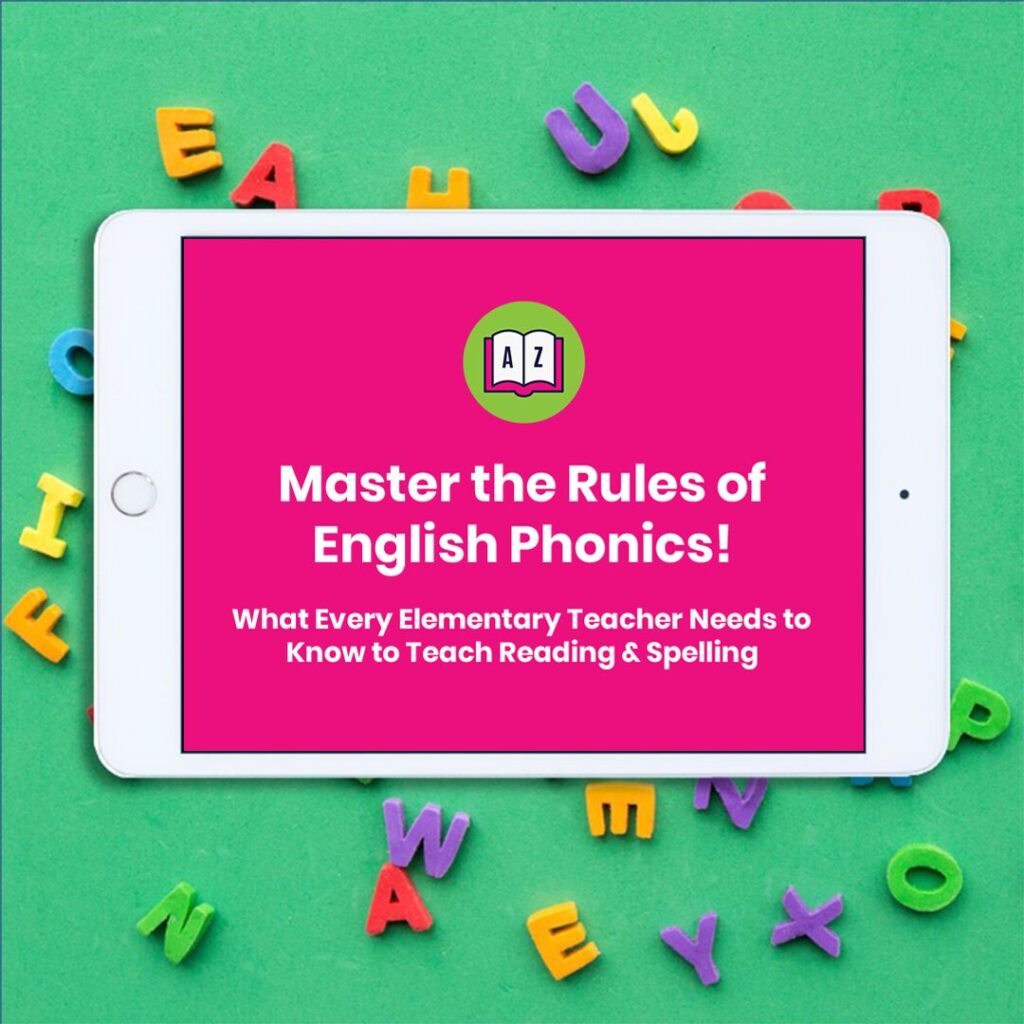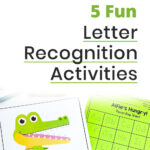Learning about the alphabet is usually one of the first steps kids take toward reading and writing! Before some of our students ever start school, someone may sing the alphabet to them, point out the shapes of letters, or maybe even have them write letters. Or they may watch alphabet videos on TV or a tablet.
But of course, there’s a lot more to consider when you’re intentionally teaching the alphabet. It’s not as easy as just singing the ABC’s!
In this post, I’m going to break down important information that Pre-K and Kindergarten teachers should know when teaching the alphabet. But guess what? Lots of this information will help ANY students who are learning to read and spell, even beyond Kindergarten!
A lot of this information may be new to you, and that’s okay! I actually didn’t learn this information from my undergraduate or graduate programs, but I sure wish I did.

Which Sounds Should Be Taught for the Alphabet?
Research shows that, when we’re teaching the alphabet, it’s effective to teach both letter names and sounds together. This means that as students learn what a letter is called and what it looks like, they should also learn about the primary sound associated with that letter. For instance, “This is the letter ‘t.’ It makes the /t/ sound as in ‘top,'” as opposed to just saying “This is the letter ‘t.’ This is the letter ‘b.’ This is the letter ‘k.'”
Which consonant sounds should be taught?
When first introducing consonants:
- Only introduce the hard sounds, not the soft sounds for the letters g and c. Hard sounds are more common than soft sounds. The letter “c” can make a hard /k/ sound as in “cat” or a soft /s/ sound as in “cent.” The letter “g” can make the hard /g/ sound as in “game” or the soft /j/ sound as in “giraffe.” Again, you only want to introduce the hard sounds when children are first learning the alphabet. (For more information on the difference between hard/soft sounds and when I recommend introducing soft sounds, read this blog “What Are the Hard and Soft G and C Sounds? What Are Some Ideas For Teaching the Hard and Soft G and C Sounds?”)
- The letter “q” needs its friend the letter “u.” Teach students that the letter “q” is a letter by itself; however, it works with the letter “u” to make the /kw/ sound.
- Practice how you say /r/ before you introduce it to students. The sound for “r” can be tricky. Many say “The letter r says /er/,” but that’s technically incorrect. The letter r just says /r/ as in “rrrrrred.” You want to remove any extra vowel sound before saying the /r/ sound. So make sure you get your mouth ready to say a word like “red” or “rain” (and then stop before you say the rest of the word!) to really isolate that /r/ sound.
- Clip the schwa sound! A schwa is an unstressed vowel that can sound like a short “u” or short “i” in an unaccented syllable. For example, the word “battle” sounds more like “batull.” That slight “uh” sound is the schwa. When teaching consonant sounds, you want to clip off that schwa sound. Let’s take the letter “w.” It can be easy to say “W says /wuh/,” and add on that “uh” part. Instead, you need to clip it and isolate the consonant sound to say “W says /w/,” and keep your mouth in the correct position. The letter “y” can also often have a schwa added if you’re not careful. So again, it’s just “Y says /y/” as in yyyyyyellow. But you would stop before the “ellow” part! Here’s the reason you don’t want to include the schwa – if a student is sounding out a new word such as “bag,” you don’t want them adding a schwa to /b/ and saying /buh/ /a/ /g/. Then, they might say “buhag.” You want it to be the pure /b/ sound to help with the blending.
- Use the /ks/ sound for the letter “x.” I prefer to use a keyword where “x” comes at the end, such as “box,” to provide an example of this sound to students. (The letter x can represent other sounds, but /ks/ is where we start.)
Which vowel sounds should be taught?
When first introducing vowels:
- Only focus on short vowel sounds at first. Yes, long vowel sounds are “easier” in one sense, because the sound is the same as the letter name for long vowels (as in “‘I’ says /i/ like in ‘ice cream'”). However, teaching the short vowels first will give students a head start on reading and writing CVC words. If you’re not familiar with that term: CVC words are often the first words kids learn to read. They are simple words with usually three letters, made up of a consonant (C), short vowel (V), and another consonant (C).
In Which Order Should the Letters Be Taught?
As of now, research has not yet pinpointed an exact order to teach the letters in. Nonetheless, research has shown us the following:
- Don’t teach all of the consonants first and then the vowels after that. The reason we want to mix in short vowels is it helps to introduce the alphabetic principle, because we can begin showing students how to read and spell CVC words (more on this below). The alphabetic principle is the concept that letters and letter combinations represent sounds, which can be put together to spell words. Without this principle, alphabet learning can be meaningless and less likely to stick!
- Ideally, you’ll teach about 5-6 consonants and a vowel to begin. Then, you explain how to use those letters (only the ones you’ve taught) to sound out and decode. For example, if you’ve taught “m, s, a, r, t, l, n” – you can start to model for students how to decode CVC words like sat, ran, nap, tan. This way, they begin to see how we put letters together to form words. And it allows them to practice their letter sounds in context.
- Teach some letters with continuous sounds first. Continuous sounds are those that can be produced in the mouth without a “stop” of air. It is usually easiest for kids to blend words that begin with these continuous sound consonants: f, l, m, n, r, s, v, z. Of course, students will need to learn non-continuous sounds, too! Words that begin with continuous sounds are just a good starting point! (Note: the vowel sounds are also continuous. So if you start with vowel-consonant words like “at,” you will still be using words that begin with continuous sounds.)
What Else Should I Know About Teaching the Alphabet?
Here are a few more tips on teaching the alphabet:
- Instead of introducing only one letter per week, I recommend introducing a couple of letters throughout each week.
- Consistent review of previously-taught letters is crucial. Always circle back and review. Multiple exposures over weeks is more effective than single-week letter introductions without review.
- Some letters in the alphabet are more common in the English language, so you can/should spend a bit more time with students on these letters. For example, the letters “e” and “r” are going to be in many more words than “q” and “x.”
What Comes After Teaching the Alphabet?
After the alphabet, I move to teaching CVC words. And because of the methods outlined above, students have already been exposed to decoding CVC words, so this is a natural progression!
Obviously, there is a lot more to learn when it comes to what to teach, beginning in Kindergarten and moving through fourth grade.
If you feel like your knowledge in this area is lacking…it’s not your fault! The truth is, most of us were never taught these rules (not in college or even grad school)! But the good news is that I have a course called “Master the Rules of English Phonics” to cover this information!

I recommend all elementary teachers take the course because it’s filled with foundational knowledge. As a teacher, you deserve to have the background knowledge you need to successfully teach your students how to spell. Click here to learn more!
Happy teaching!












